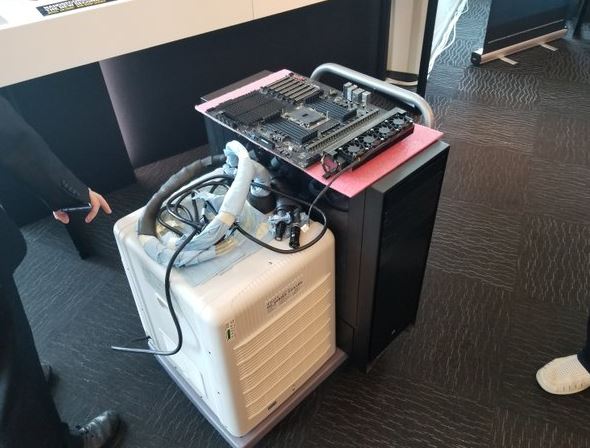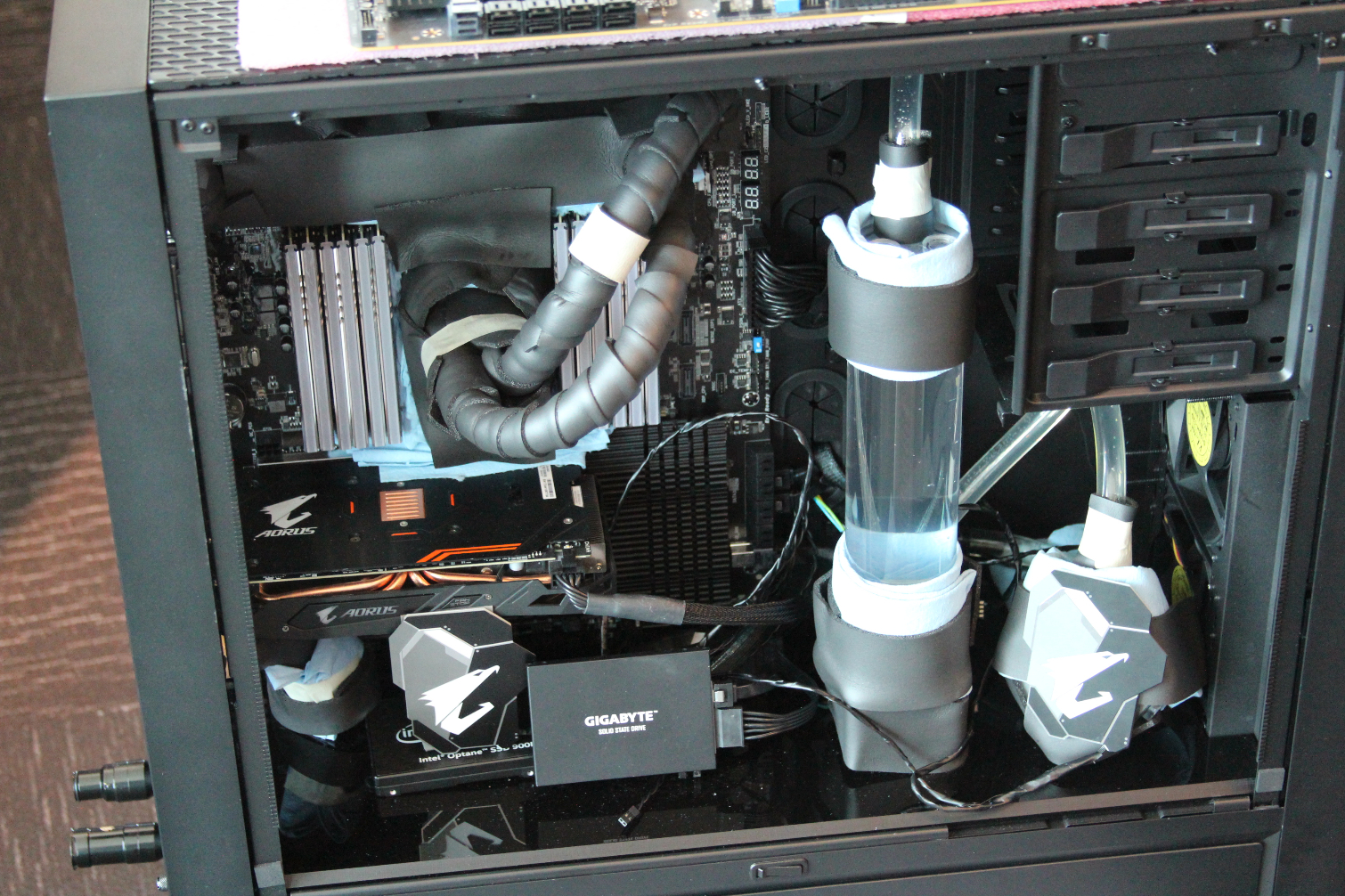Intel's 28-Core 5GHz Processor And Test System Breaks Cover (Updated)
We tracked down Intel's demo system at the show to get a closer look at the new motherboard and system that supports the company's 28-core processor. We found that the company tested the processor with a hefty overclock that required a massive water chiller.
Intel's Computex presentation surprisingly included the overclocked 28-core processor at an impressive 5.0 GHz, but as per usual for a tradeshow demo, the company didn't share many details. AMD released a new 32-core Threadripper 2 model here at Computex, and Intel's announcement that it will ship a 28-core model this year was clearly designed to steal some of AMD's thunder before its announcement.
The center of the motherboard is dominated by the massive 3,647-pin LGA3647 socket, which is flanked by six DIMM slots on each side. These memory slots feed the six-core memory controller onboard the chip, which is largely thought to be a $10,000 Xeon Platinum Scalable 8180 server processor with an unlocked multiplier. The board has four eight-pin EPS power connectors. The processor requires a 1000W power supply to feed adequate power for overclocking.


The motherboard features a 32-phase power delivery subsystem. A massive finned heatsink with four fans cools the VRMs.














Intel's demo didn't tell the full story. Many in the press mistakenly assumed the new processor runs at 5.0 GHz at stock settings, but we carefully analyzed video from the event and spotted a few obvious signs that the processor was overclocked. Intel was apparently running some sort of closed-loop cooling that required insulating material around the tubing. This turns out to be a water chiller hidden under the table. As expected, all of the components are properly shielded to avoid excess condensation from the chilled liquid.


The one-horsepower Hailea HC-1000B is a beefy water chiller that can dissipate tremendous amounts of waste heat, but it also requires more than 1,000W for operation. We were originally going to witness the demo first hand, but there wasn't enough power handy to run both the chiller and the system simultaneously.
Intel's new 28-core processor is likely similar to the Xeon Platinum 8180. This processor lands with a $10,000 MSRP for data center users, and given its target market, it doesn't come with an unlocked multiplier. Releasing an enterprise model with an unlocked multiplier to the general market is a tricky proposition for Intel, as data center and high performance computing users will jump on the unlocked models, thus plundering sales of high-margin Xeon models. As such, we can expect Intel will charge a hefty premium for its new 28-core models and employ some type of defeaturing, such as removing AVX-512, ECC, and multi-socket support to discourage the practice.
Get Tom's Hardware's best news and in-depth reviews, straight to your inbox.
Intel processors have much higher frequency headroom than AMD's processors, both at stock settings and after overclocking. The 5.0 GHz overclock makes Intel's new processor all the more impressive compared to AMD's relatively tame clock speeds. Intel's large monolithic die also features a cohesive mesh interconnect, while AMD's Threadripper processors have a distributed MCM design that connects multiple die via the Infinity Fabric. AMD's implementation can suffer from reduced performance in games and some applications, although the company does offer several parameters that users can tweak to reduce the impact. In either case, Intel's enthusiast-class processors generally lead competing AMD models in lightly threaded games and applications. Adding more multi-threaded heft with 28-core models will help Intel address one of its remaining weaknesses compared to Threadripper processors, but pricing will be a problem.
In the end, the incredible requirements for overclocking the 28-core processor, which requires hefty power and cooling accomodations, make it clear that most enthusiasts won't be pushing the limits of Intel's 28-core processor any time soon.

Paul Alcorn is the Editor-in-Chief for Tom's Hardware US. He also writes news and reviews on CPUs, storage, and enterprise hardware.
-
mihen There is no such thing as too many cores as long as it does not hinder single threaded performance.Reply -
giovanni86 Intel needs to price it right. It can't be more then 2k. I feel 2k is too steep. With AMD having a big piece of the pie now, intel shouldnt hold out. We all know threadripper 2 will be priced equal to its predecessor thats just how AMD rolls and they've won strides doing so. Now we just need AMD to announce a killer AMD GPU to dethrone Nvidias jenson so he can finally wake up and see that delaying a release will cost you greatly!Reply -
Valantar Reply
That, my friend, is some serious wishful thinking. The current 18-core model is already at $2000, and the enterprise variant of this is ~$10000. Selling the same product (even with ECC or some PCIe lanes removed) at 1/5th of the price? Yeah, that's not going to happen.21031860 said:Intel needs to price it right. It can't be more then 2k. I feel 2k is too steep. With AMD having a big piece of the pie now, intel shouldnt hold out. We all know threadripper 2 will be priced equal to its predecessor thats just how AMD rolls and they've won strides doing so. Now we just need AMD to announce a killer AMD GPU to dethrone Nvidias jenson so he can finally wake up and see that delaying a release will cost you greatly!
My guess: around ~$3500. Remember, chips like these are mainly for the "never even looks at the price tag" crowd.
Also: has nobody noticed that utterly insane VRM setup? I think I counted 28 phases (or 14 doubled, I suppose, which is mostly the same thing). Holy utter ****. No wonder, really, as this thing was likely pulling 800W through the CPU cores alone (CFL at 5-5.1GHz is around 160-200W - subtract ~10W for the uncore and divide by 6, and you have 25-30W per core). But still: wow. Wonder how many current cases the motherboards for these things will actually fit into. -
BulkZerker "The 5.0 GHz overclock makes Intel's new processor all the more impressive compared to AMD's relatively tame clock speeds. "Reply
Not at all impressive when..
"there wasn't enough power handy to run both the chiller and the system simultaneously."
This setup needs more Than 20 amps to run? Ha, hah hah, *amused chortle*.
Intel is in full panic right now to do this as their response to a processor that will cost less (I'm guessing 1/4 the price of this chip if not less), will use less power (maybe 400 watts full load), and "somehow" manages to provide comparable performance.
The only reason to buy Intel hedt right now is you flat do not have space and must have as much performance as possible in that limited space. -
Valantar Reply21032984 said:"The 5.0 GHz overclock makes Intel's new processor all the more impressive compared to AMD's relatively tame clock speeds. "
Not at all impressive when..
"there wasn't enough power handy to run both the chiller and the system simultaneously."
This setup needs more Than 20 amps to run? Ha, hah hah, *amused chortle*.
Intel is in full panic right now to do this as their response to a processor that will cost less (I'm guessing 1/4 the price of this chip if not less), will use less power (maybe 400 watts full load), and "somehow" manages to provide comparable performance.
The only reason to buy Intel hedt right now is you flat do not have space and must have as much performance as possible in that limited space.
AnandTech got some hands-on time with the PC and the chiller. Apparently the chiller requires 9.6A alone, with a cooling capability of ~1.7KW. Alongside that, we can expect a single ~5GHz CFL core to consume ~25-30W. Times 28, that's 700-840 for the CPU cores alone. Then there are VRM losses, which even given the silly 28-phase VRM on the test board would be significant at that kind of power (even at 95% efficiency that's another 35-42W). Then there's the CPU Uncore (negligible at this wattage, but still). and 6-channel memory (looks like the build was fully populated with 12 DIMMs) which should account for a decent amount of power again. And whatever GPU and so on they had in there, motherboard power, and PSU losses. And probably a hefty water pump, if the chiller wasn't running while the demo was done. -
Non-Euclidean What a joke. This monstrosity by Intel is as feasible as driving a rocket powered car down the road next year.Reply -
John Nemesh This is a desperation move from Intel. It's nowhere NEAR release, as was shown when Intel (wisely) decided to pull these from the show floor (including from other OEMs).Reply
AMD, on the other hand, showed a consumer-ready product that is functional with air cooling, and will be released this fall.
Some people don't want to admit that the company with an 89% marketshare is in trouble. This show proves them wrong. Intel is going to have a rough 2018, and an even rougher 2019. -
bugnguts 1.7kW of cooling is more than the largest window mounted AC units, 750W to 1400W is typical for window AC. On top of that, the test was only 7s long. Intel has hit a thermal wall. I've said it before and I will repeat Intel is stuck at 14nm because 10nm is too small. Yes, less power but also much less cross sectional area to transfer heat through chip and then chip to the spreader. This is why Intel only releases low power low core count at 10nm. Who wants to upgrade to a slower processor? This hits Intel's server-class hard due to high core counts. This is a big problem because the problem is inherent in the architecture. They would have had a few more years to work on it but AMD shows up with Ryzen which has higher IPC, core counts and clock speeds with the 2nd iteration which suggest this architecture has room to grow. AMD then shows an 7nm EPYC and says the chip will ship by end of year. If the 7nmEPYC has higher clocks and better efficiency Intel server chips will have little appeal.Reply